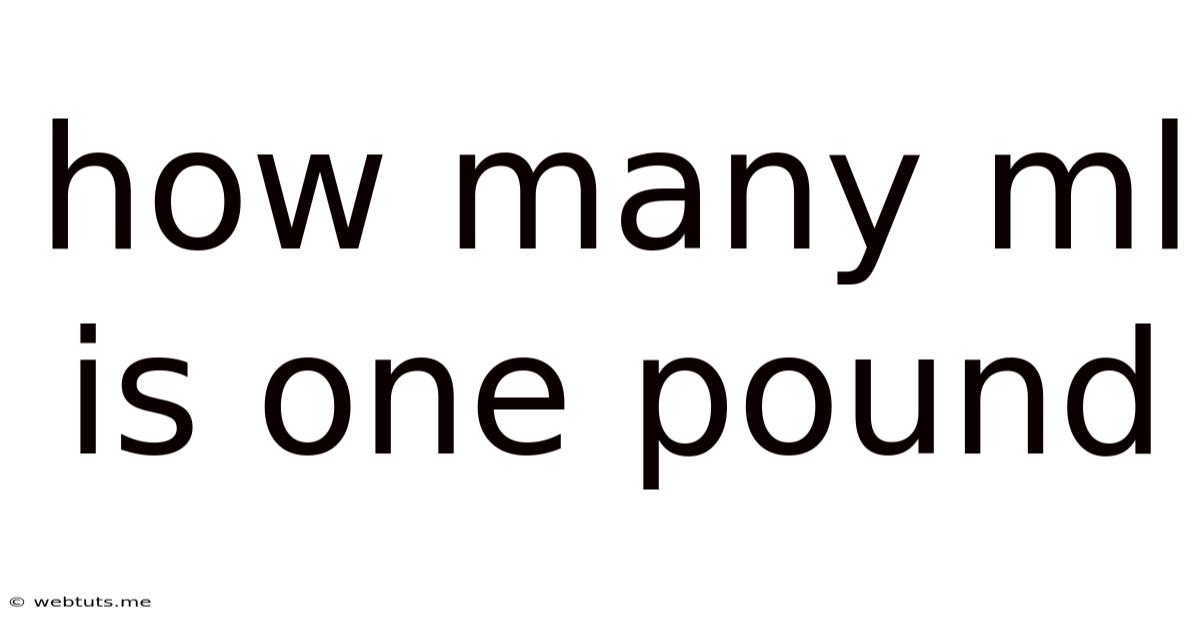How Many Ml Is One Pound
Webtuts
May 09, 2025 · 4 min read

Table of Contents
How Many Milliliters is One Pound? Understanding Volume and Weight Conversions
The question "How many milliliters is one pound?" is a common one, but it doesn't have a straightforward answer. This is because milliliters (mL) measure volume, while pounds (lbs) measure weight or mass. To convert between them, you need to know the density of the substance you're measuring. Density is the mass per unit volume, often expressed as grams per milliliter (g/mL) or pounds per cubic foot (lbs/ft³). Water, for instance, has a density of approximately 1 g/mL, making the conversion relatively simple for water-based calculations. However, for other substances, the conversion becomes significantly more complex.
This article will delve deep into this conversion, explaining the complexities, providing examples for different substances, and clarifying common misconceptions.
Understanding the Difference Between Volume and Weight
Before tackling the conversion, it's crucial to understand the fundamental difference between volume and weight:
-
Volume: This refers to the amount of three-dimensional space a substance occupies. It's measured in units like liters (L), milliliters (mL), cubic centimeters (cm³), cubic inches (in³), etc. Think of it as how much space something takes up.
-
Weight/Mass: This refers to the amount of matter in a substance. Weight is specifically the force exerted on that matter by gravity. Mass, on the other hand, remains constant regardless of gravitational pull. While often used interchangeably in everyday language, the distinction is important in scientific contexts. Weight is measured in units like pounds (lbs), kilograms (kg), grams (g), ounces (oz), etc.
The relationship between volume and weight is determined by density. A denser substance will have more mass in the same volume compared to a less dense substance.
Converting Pounds to Milliliters: The Density Factor
The core equation for this conversion is:
Volume (mL) = Mass (g) / Density (g/mL)
Since we're dealing with pounds, we need to first convert pounds to grams:
- 1 pound (lb) ≈ 453.592 grams (g)
Now let's look at specific examples:
1. Water: A Simple Conversion
For water, the density is approximately 1 g/mL. Therefore, the conversion is relatively straightforward:
- 1 pound of water ≈ 453.592 mL
This means that one pound of water occupies approximately 453.592 milliliters of space. This is a commonly used approximation, and it's essential to remember that slight variations may occur based on temperature and pressure.
2. Oil: A More Complex Scenario
Oil has a lower density than water. Let's assume the density of a particular type of oil is 0.9 g/mL. The conversion would be:
- Volume (mL) = 453.592 g / 0.9 g/mL ≈ 504 mL
Notice that one pound of oil occupies a larger volume (504 mL) than one pound of water (453.592 mL) because oil is less dense.
3. Mercury: An Extremely Dense Substance
Mercury is significantly denser than water. Let's assume its density is 13.5 g/mL. The conversion becomes:
- Volume (mL) = 453.592 g / 13.5 g/mL ≈ 33.6 mL
This illustrates that a pound of mercury occupies a much smaller volume than a pound of water or oil due to its high density.
Common Misconceptions and Important Considerations
Several misconceptions surround the pound-to-milliliter conversion:
-
No Universal Conversion Factor: There's no single conversion factor for pounds to milliliters. The conversion always depends on the density of the substance. Using a conversion factor without considering density will lead to inaccurate results.
-
Temperature and Pressure: Density is affected by temperature and pressure. For highly precise conversions, you need to consider the temperature and pressure at which the measurement is taken.
-
Substance Purity: The purity of a substance impacts its density. Impurities can alter the density and therefore affect the volume calculation.
-
Approximations: Many density values are approximations. Using more precise density values will yield more accurate results.
Practical Applications and Real-World Examples
Understanding this conversion has several practical applications:
-
Cooking and Baking: Recipes often specify ingredients by weight, while some measuring tools measure volume. Knowing how to convert between weight and volume is essential for accurate cooking.
-
Chemistry and Physics: Accurate conversions are crucial in experiments and calculations involving various substances.
-
Engineering and Manufacturing: Precise volume calculations are essential in various engineering applications.
Expanding the Knowledge Base: Beyond Water, Oil, and Mercury
The examples above focused on water, oil, and mercury to illustrate the principle. However, countless substances exist, each with its unique density. To find the appropriate conversion factor, you would need to find the density of that specific substance. This information is often available in scientific literature, chemical handbooks, or online databases.
Remember to always consult reliable sources for accurate density information for your specific application. Using inaccurate density values will lead to inaccurate volume calculations.
Conclusion: Mastering the Pound-to-Milliliter Conversion
Converting pounds to milliliters requires understanding the concept of density and its crucial role in bridging the gap between weight and volume. There is no single universal conversion factor. The conversion calculation is specific to each substance. Always remember to consult reliable sources for accurate density data and take into account factors like temperature, pressure, and purity for highly accurate conversions. By understanding these principles, you can accurately convert between pounds and milliliters for various applications, ensuring precision and accuracy in your measurements.
Latest Posts
Latest Posts
-
How Many Days Until The 31
May 11, 2025
-
How Many Cups Is 700 Ml
May 11, 2025
-
40 Ounces Equals How Many Cups
May 11, 2025
-
How Much Stain For A Fence
May 11, 2025
-
500 Yards Is How Many Miles
May 11, 2025
Related Post
Thank you for visiting our website which covers about How Many Ml Is One Pound . We hope the information provided has been useful to you. Feel free to contact us if you have any questions or need further assistance. See you next time and don't miss to bookmark.